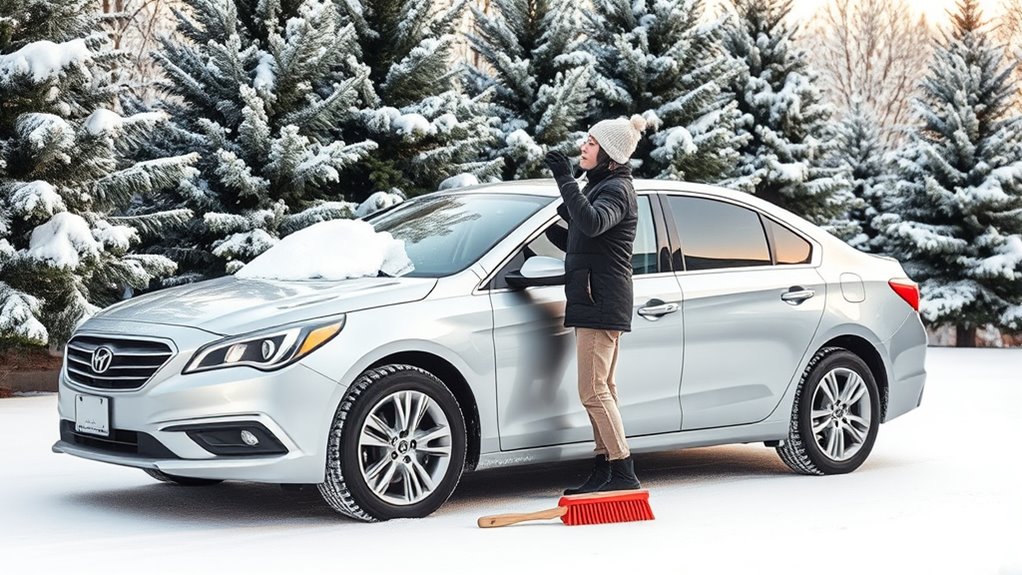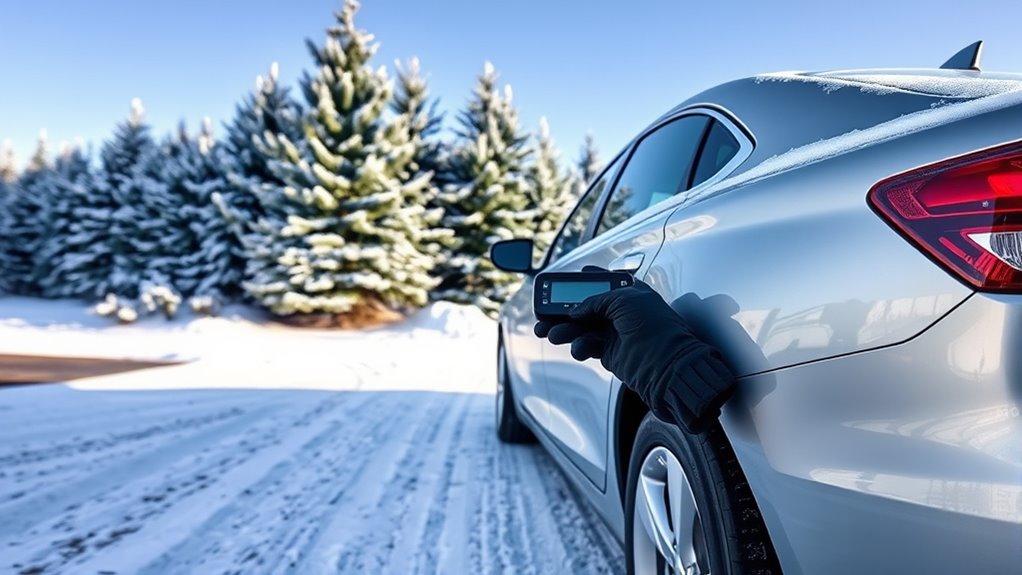To prepare your car for winter, start by checking and inflating your tires to the recommended pressure, and switch to winter tires if possible for better grip. Inspect your battery’s condition since cold weather can weaken it, and keep terminals clean. Regularly monitor tire tread depth and pressure, and make certain your vehicle’s fluids are suitable for low temperatures. Staying ahead with these steps will help you stay safe; explore more tips to fully winter-proof your car.
Key Takeaways
- Check and adjust tire pressure regularly, and consider switching to winter tires for better traction.
- Inspect battery health and replace it if showing signs of weakness, as cold weather reduces efficiency.
- Ensure all vehicle fluids are topped up and use winter-grade oil to prevent freezing issues.
- Keep an accessible, fully inflated spare tire and verify tire tread depth for safe driving.
- Test and maintain vehicle lights, defrosters, and brakes to ensure optimal performance in winter conditions.

As winter approaches, it is vital to prepare your car to handle the colder months safely and reliably. This means paying close attention to tire maintenance and battery care, two essential aspects that can greatly impact your vehicle’s performance and safety during winter. Start by inspecting your tires. Cold weather can cause the air pressure to drop, so check your tire pressure regularly and inflate them to the manufacturer’s recommended levels. Properly inflated tires improve traction on icy or snowy roads and help prevent uneven wear. Consider switching to winter tires if you haven’t already; their specialized rubber compounds and tread patterns provide better grip in low temperatures and on snow-covered surfaces. Additionally, examine the tire tread depth—if it’s worn down below the recommended level, replace your tires to guarantee ideal traction. Keep a spare tire in good condition, fully inflated, and accessible, so you’re prepared for any emergencies.
Regularly inspecting and maintaining these components will help you avoid breakdowns and keep your vehicle running smoothly all winter long. Taking these proactive steps now guarantees you’re prepared to face winter weather confidently, reducing the risk of accidents and inconvenient repairs once the temperatures drop. It’s also beneficial to be aware of your vehicle’s homeostasis—the ability to maintain optimal operating conditions in changing environments—so you can take appropriate steps to support your car’s health during the cold months.
Frequently Asked Questions
How Often Should I Check My Tire Pressure in Winter?
You should check your tire pressure regularly during winter, ideally once a month, to guarantee ideal tire pressure maintenance. Cold weather causes tire pressure to drop, so frequent checks help prevent unsafe driving conditions. Follow winter tire tips by inspecting tires more often if you experience temperature fluctuations or long trips. Proper tire pressure improves traction, fuel efficiency, and safety, making consistent checks a key part of winter driving preparedness.
Can I Use Regular Windshield Washer Fluid in Winter?
You shouldn’t use regular windshield washer fluid in winter because it can freeze, making it ineffective. Instead, opt for winter washer fluid, which is formulated to withstand low temperatures. If you’re in a pinch, consider windshield fluid alternatives like a mixture of water and a small amount of alcohol or antifreeze. These options help keep your windshield clear, ensuring safe driving during cold weather conditions.
What’S the Best Way to Prevent Battery Failure in Cold Weather?
Imagine your battery freezing and leaving you stranded in the coldest moment—scary, right? To prevent this, focus on battery maintenance and cold weather charging. Keep your terminals clean and tight, check the charge regularly, and consider a trickle charger if your car sits idle. Cold weather can be tough on batteries, but with proactive care, you’ll stay powered up and ready to go, no matter how frosty it gets.
How Do I Protect My Car’S Paint From Winter Salt?
To protect your car’s paint from winter salt, you should regularly wash your vehicle, especially the undercarriage, to remove salt residue. Applying a good car waxing or paint sealant creates a barrier that prevents salt from damaging the paint. These protective layers help preserve your car’s finish, keeping it looking new longer. Make sure to reapply wax or sealant as recommended for ongoing protection throughout the winter months.
Are Snow Tires Necessary for City Driving?
You might wonder if snow tires are necessary for city driving. While some believe winter tire myths, like they’re only for rural areas, they actually help reduce city driving hazards such as icy patches and snow-covered streets. If you experience frequent winter storms or icy sidewalks, investing in winter tires provides better traction, safety, and control. Don’t dismiss their importance; they’re a smart choice for steering winter city streets confidently.
Conclusion
As you finish checking your tires and topping off your antifreeze, imagine slipping behind the wheel on a crisp winter morning. The snow crunches softly beneath your tires as you glide smoothly, confident your car is ready for whatever the season throws at you. With these simple steps done, you can embrace winter’s chill knowing your car won’t let you down. Drive safely and enjoy the quiet beauty of the season ahead.









